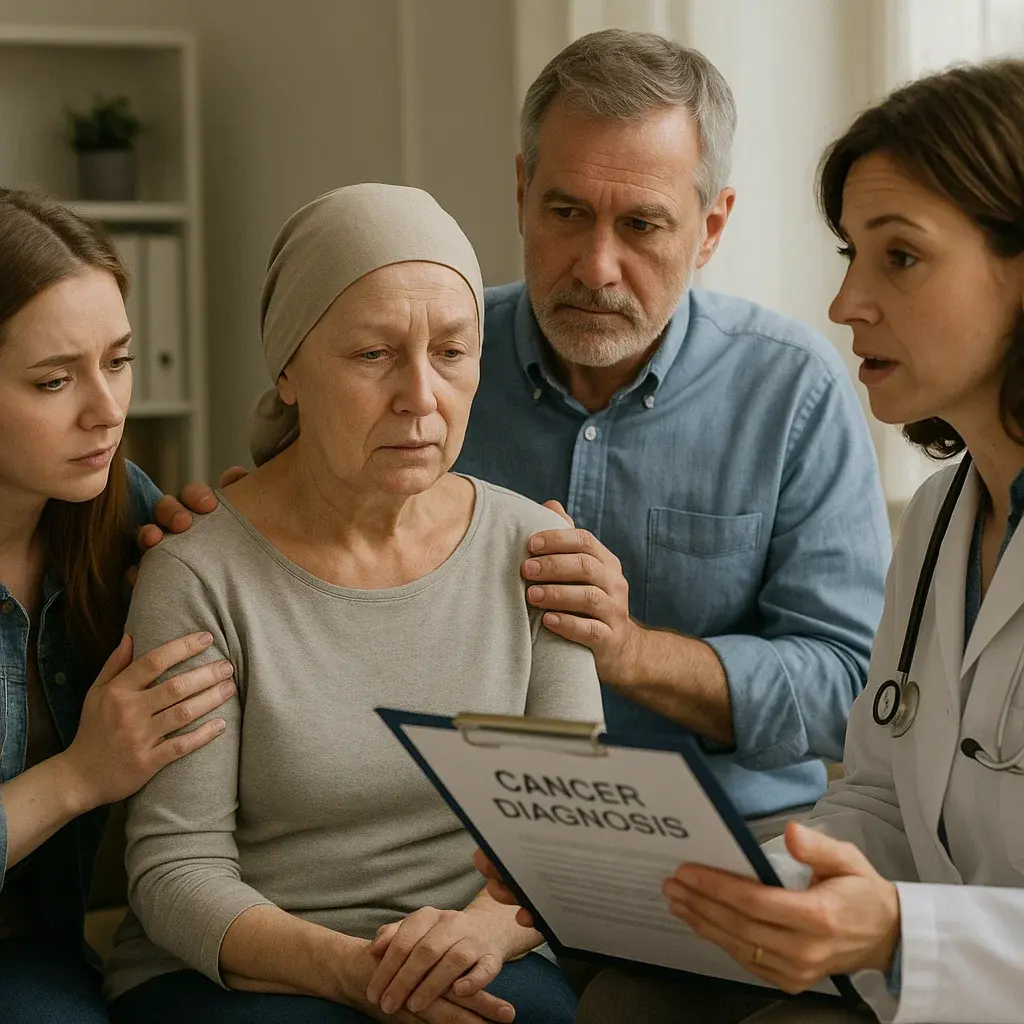Hearing the words "you have cancer" is a moment that changes everything. It’s like the ground shifts beneath your feet. Fear, confusion, anger, numbness – these feelings are all completely normal. If you’re reading this, whether you’re the patient or someone who loves them, please know this: You are not alone. Millions navigate this cancer diagnosis path …
Hearing the words “you have cancer” is a moment that changes everything. It’s like the ground shifts beneath your feet. Fear, confusion, anger, numbness – these feelings are all completely normal. If you’re reading this, whether you’re the patient or someone who loves them, please know this: You are not alone. Millions navigate this cancer diagnosis path every year, and while it’s incredibly challenging, understanding what’s happening and knowing your options can bring a sense of control and hope. This guide focuses on facts, practical steps, and supportive strategies, grounded in science and compassion.
What Does a “Cancer Diagnosis” Actually Mean?
Simply put, a cancer diagnosis means that doctors have found cells in your body growing abnormally and uncontrollably. Unlike healthy cells that grow, divide, and die in an orderly way, cancer cells ignore the body’s signals to stop dividing or to die. They can invade nearby tissues and sometimes spread (metastasize) to other parts of the body through the blood or lymph systems. A diagnosis isn’t just a label; it’s the starting point for understanding the specific type, location, stage (how far it has spread), and ultimately, planning the best way to manage it.
How Do Doctors Find Cancer? The Diagnostic Journey
Getting a cancer diagnosis isn’t usually a single test. It’s often a process:
- Initial Concern: It often starts with symptoms (see below) or findings during a routine check-up or screening test.
- Medical History & Physical Exam: Your doctor will ask detailed questions about your health, family history, and symptoms and perform a thorough physical exam.
- Diagnostic Tests: Based on the exam and history, specific tests are ordered to look for cancer or rule it out. This is where the detective work intensifies.
What Are 5 Key Ways to Detect Cancer?
Doctors have several tools to find and confirm cancer:
- Imaging Tests: These create pictures of the inside of your body.
- X-rays: Often used for bones and chest.
- CT Scans (Computed Tomography): Detailed cross-sectional images using X-rays. Great for finding tumors and seeing spread.
- MRI (Magnetic Resonance Imaging): Uses magnets and radio waves for detailed images, especially of soft tissues like the brain, spinal cord, muscles, and organs.
- Ultrasound: Uses sound waves to create images, commonly used for abdominal organs, breasts, and thyroid.
- PET Scans (Positron Emission Tomography): Involves injecting a small amount of radioactive sugar. Cancer cells, which use more energy, absorb more of it, lighting up on the scan. Often combined with a CT scan (PET-CT).
- Laboratory Tests: Analyzing blood, urine, or other body fluids.
- Blood Tests: Can show how organs are functioning and sometimes detect markers that suggest cancer might be present (like PSA for prostate cancer or CA-125 for ovarian cancer). Can a blood test detect cancer in the body? While blood tests can find clues (like tumor markers, abnormal blood cell counts, or circulating tumor cells – an area of intense research called “liquid biopsies”), they are rarely definitive proof on their own. They are crucial pieces of the puzzle used alongside other tests. A normal blood test doesn’t rule out cancer, and an abnormal one doesn’t always mean cancer is present.
- Biopsy: This is usually the only definitive way to diagnose cancer. A doctor removes a small sample of tissue (cells) from the suspicious area. A pathologist (a doctor specializing in diagnosing disease) examines these cells under a microscope to look for cancer cells and determine the type. Types of biopsies include needle biopsy, endoscopic biopsy, or surgical biopsy.
- Endoscopy: A thin, flexible tube with a light and camera (endoscope) is used to look inside body cavities like the digestive tract, lungs, or bladder. Doctors can often take biopsy samples during these procedures.
- Genetic Tests: Sometimes performed on cancer cells (from a biopsy) or blood/saliva to identify specific gene mutations driving the cancer. This is increasingly important for guiding targeted treatments.
What Are 7 Potential Symptoms of Cancer?
It’s vital to remember that these symptoms are far more often caused by conditions other than cancer. However, if they are persistent, unexplained, or worsening, it’s essential to see a doctor:
- Unexplained Weight Loss: Losing 10 pounds or more without trying.
- Persistent Fatigue: Extreme tiredness that doesn’t improve with rest.
- Pain: Ongoing pain without a clear cause, especially if new or worsening (e.g., persistent headaches, bone pain, abdominal pain).
- Skin Changes: Yellowing (jaundice), darkening, redness, sores that don’t heal, or noticeable changes to a mole (size, shape, color, bleeding).
- Changes in Bowel or Bladder Habits: Persistent constipation, diarrhea, blood in stool or urine, pain when passing urine, or changes in bladder frequency.
- Unusual Bleeding or Discharge: Coughing up blood, blood in vomit, unusual vaginal bleeding, or bloody discharge from a nipple.
- Persistent Lump or Thickening: Any new lump or thickening felt under the skin, especially in the breast, testicle, lymph nodes (neck, armpit, groin), or elsewhere.
What Are the Top 3 Cancer Diagnoses?
Globally, the most commonly diagnosed cancers (based on World Health Organization data) are:
- Breast Cancer: The most common cancer worldwide.
- Lung Cancer: The leading cause of cancer death globally.
- Colorectal Cancer: Cancers of the colon or rectum.
This list varies slightly by country and gender, but these three consistently rank at the top.
Early Detection: Catching It Sooner
Finding cancer early, before it has grown large or spread, significantly improves treatment success rates. Early cancer detection tests are screening tools used on people without symptoms:
- Mammograms: X-rays for breast cancer screening.
- Pap Smears & HPV Tests: Screen for cervical cancer.
- Colonoscopy/Sigmoidoscopy/Stool Tests: Screen for colorectal cancer.
- Low-Dose CT Scans: Recommended for high-risk individuals (like long-term smokers) to screen for lung cancer.
- PSA Blood Test (with caveats): Sometimes used for prostate cancer screening, though its use is individualized due to risks of overdiagnosis. Discuss with your doctor.
Understanding Your Diagnosis: The “Cancer Diagnosis List” and Staging
Once cancer is confirmed by biopsy, your doctor will determine the specific type (e.g., invasive ductal carcinoma, adenocarcinoma, squamous cell carcinoma) and its stage. Staging describes the size of the tumor and how far it has spread. The most common system is TNM:
- T (Tumor): Size and extent of the primary tumor.
- N (Nodes): Whether cancer has spread to nearby lymph nodes.
- M (Metastasis): Whether cancer has spread to distant organs.
Stages are usually grouped as 0 (very early, confined to site of origin) to IV (advanced, spread to distant organs). Staging is crucial for determining prognosis and the best treatment options. You can often find detailed explanations of specific cancer types and staging in reputable cancer diagnosis PDF resources from organizations like the National Cancer Institute (NCI) or the American Cancer Society (ACS).
Conventional Cancer Treatment: The Foundation
Treatment plans are highly personalized, depending on the type, stage, location, genetic markers, and your overall health. Often, a combination of approaches is used:
- Surgery: Physically removing the tumor and some surrounding healthy tissue. Often the primary treatment for solid tumors that are localized.
- Radiation Therapy: Using high-energy rays (like X-rays or protons) to kill cancer cells or shrink tumors. Can be delivered externally or internally (brachytherapy).
- Chemotherapy (“Chemo”): Using powerful drugs to kill cancer cells or stop them from growing/dividing. Often travels throughout the body (systemic treatment).
- Immunotherapy: Boosts your body’s own immune system to recognize and destroy cancer cells more effectively. A rapidly advancing field.
- Targeted Therapy: Uses drugs designed to attack specific molecules or pathways that cancer cells need to grow and survive. Often based on genetic testing of the tumor.
- Hormone Therapy: Blocks or lowers the levels of certain hormones that fuel the growth of some cancers (like breast and prostate cancer).
- Bone Marrow Transplant/Stem Cell Transplant: Replaces diseased bone marrow with healthy stem cells. Used for cancers like leukemia, lymphoma, and multiple myeloma.
Supportive Care: Managing Symptoms and Enhancing Well-being
Cancer and its treatments can cause side effects (fatigue, pain, nausea, anxiety, weakened immunity). Supportive care, also called palliative care, focuses on preventing and relieving these symptoms and improving quality of life at any stage. It works alongside curative treatment. This includes:
- Medications for pain and nausea.
- Nutritional support.
- Physical and occupational therapy.
- Counseling and psychological support.
- Integrative Therapies: Evidence-based complementary approaches used alongside conventional treatment to manage side effects and improve well-being. This is where many find significant relief.
Exploring Evidence-Based Supportive Therapies Cancer Diagnosis
While conventional treatments target the cancer itself, integrative therapies aim to support the body, manage side effects, and improve resilience during treatment and recovery. It’s crucial to discuss any new therapy with your oncology team to ensure safety and avoid interactions. Here’s a look at some approaches with emerging scientific interest for supportive care:
- EBOO Ozone Therapy (Extracorporeal Blood Oxygenation and Ozonation): This involves drawing a small amount of blood, mixing it with medical-grade ozone gas, and returning it to the body. Peer-reviewed research (primarily preclinical and some clinical studies) suggests ozone may influence cellular metabolism and immune function. Studies indicate potential benefits like improved oxygen delivery to tissues, modulation of inflammation, and enhanced antioxidant defenses (Evidence-Based Complementary and Alternative Medicine, International Journal of Molecular Sciences). Importantly, it’s being explored for its potential role in managing cancer-related fatigue, improving quality of life, and supporting detoxification pathways burdened by conventional treatments – not as a direct cancer treatment. Rigorous, large-scale human trials specific to cancer support are ongoing.
- Regenerative Therapy: This broad field focuses on harnessing the body’s natural healing mechanisms. In a supportive context for cancer patients, approaches might include:
- Platelet-Rich Plasma (PRP): Concentrated platelets from your own blood, injected to potentially aid tissue healing and reduce inflammation, relevant for managing side effects like oral mucositis (mouth sores from chemo/radiation) or supporting tissue repair post-surgery (Supportive Care in Cancer).
- Exosome Therapy: Exosomes are tiny vesicles released by cells that carry signaling molecules. Research is exploring how certain exosomes (often derived from stem cells) might modulate inflammation and support tissue regeneration (Journal of Translational Medicine, Stem Cell Research & Therapy). Their potential role in mitigating treatment side effects or promoting healing is an active area of investigation.
- Important Note: Regenerative therapies like stem cell transplants (using the patient’s own or donor cells) are established treatments for specific blood cancers (leukemia, lymphoma) but are fundamentally different from the PRP or exosome therapies mentioned above for supportive care.
Other Supportive Therapies That May Help Manage Symptoms and Side Effects:
Many wellness centers offer therapies focused on symptom relief and improving quality of life during and after conventional cancer treatment. Always prioritize safety and coordination with your medical team:
- IV Therapy: Hydration and nutrient support (like high-dose vitamin C – though high-dose IVC efficacy in cancer treatment is debated and should only be done under strict medical supervision for potential symptom support). “Immunity drips” often focus on vitamins and minerals supporting general immune health.
- Cryotherapy: Brief exposure to extreme cold may help reduce inflammation and muscle soreness.
- Infrared Sauna: Gentle heat may promote relaxation, reduce muscle tension, and support detoxification (primarily through sweating).
- Red Light Therapy (RLT): May support skin health and wound healing, potentially helpful for skin issues caused by radiation.
- Oxygen Bar: Supplemental oxygen might provide a temporary feeling of increased alertness or energy for some.
- Metabolic Testing (PNOE): Understanding your unique metabolism can help tailor nutrition plans to maintain strength and energy levels during treatment.
- Massage Therapy: Proven to reduce stress, anxiety, pain, and nausea.
- Nutritional Counseling: Vital for maintaining strength, managing treatment side effects, and supporting healing.
Coping Strategies: For the Patient
- Gather Your Support Team: Lean on family, friends, support groups (online or in-person). Don’t isolate yourself.
- Communicate with Your Medical Team: Ask questions, express concerns, understand your treatment plan. Bring someone to appointments to take notes.
- Prioritize Self-Care: Focus on nutrition (seek a dietitian), gentle movement as tolerated (consult your doctor), hydration, and sleep. Manage stress through mindfulness, meditation, or gentle yoga.
- Manage Information Intake: It’s easy to get overwhelmed online. Stick to reputable sources (NCI, ACS, major cancer centers). Set boundaries on how much you research at once.
- Allow Yourself to Feel: All emotions are valid. Seek counseling or therapy if needed. It’s a sign of strength, not weakness.
- Focus on What You Can Control: Your attitude, your support system, your self-care routines.
Coping Strategies: For Loved Ones
- Listen More, Fix Less: Often, the best support is simply being present and listening without judgment or unsolicited advice.
- Offer Practical Help: Specific offers are better than “let me know if you need anything.” “Can I drive you to chemo?” “I’m making lasagna, can I bring some?” “Can I pick up groceries?”
- Respect Boundaries: Understand needs change. Ask what they need today. Respect their need for rest or privacy.
- Educate Yourself: Learn about their specific diagnosis and treatment to better understand what they’re going through (but avoid overwhelming them with facts).
- Take Care of Yourself: Supporting someone with cancer is emotionally taxing. Ensure you get rest, nutrition, and support for yourself. You can’t pour from an empty cup.
- Avoid Toxic Positivity: It’s okay to acknowledge how hard this is. Saying “stay positive” can sometimes feel dismissive of their real fears and pain.
You Are Truly Not Alone
A cancer diagnosis is a profound challenge, but it’s not one you face in isolation. A vast network of medical professionals, researchers, support groups, and fellow patients and caregivers surrounds you. Understanding the diagnostic process, treatment options, and supportive strategies empowers you to be an active participant in your care. Remember, integrating supportive therapies should always be done thoughtfully and in partnership with your oncology team to ensure safety and synergy with your primary treatment plan.
Taking the Next Step Towards Supportive Care
If you’re exploring integrative and supportive therapies to help manage symptoms, improve your quality of life, and enhance your body’s resilience during or after conventional cancer treatment, specialized guidance is essential.
Wellness Revolution Texas offers a range of evidence-informed supportive therapies, including consultations on EBOO Ozone Therapy and Regenerative Therapy options, alongside modalities like IV therapy, metabolic testing, cryotherapy, and infrared sauna. Their focus is on creating personalized wellness plans to complement your medical care.
Ready to explore how supportive therapies might fit into your journey? Book your free consultation with Wellness Revolution Texas today. Discuss your unique situation, ask questions, and learn about options that might help you feel stronger and more supported. Visit their website or call [Insert Phone Number/Booking Link Here] to schedule. Take this step towards empowering your well-being alongside your medical treatment.





